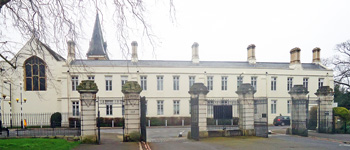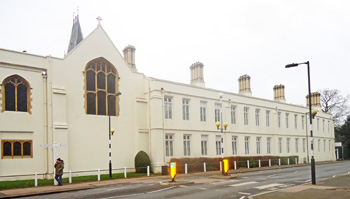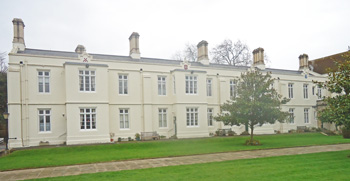|
Edward Alleyn House Old College, College Road, Dulwich, SE21 7AS
|
In 1613 the renowned Shakespearean actor Edward Alleyn (1566-1626), who owned the Manor of Dulwich, founded and endowed the College of God's Gift.
Building work began in 1613 and the College was completed in the autumn of 1616. It consisted of a chapel, a school and 12 almshouses.
In 1619 the College was incorporated. The charity consisted of a Master, a Warden, four Fellows (the chaplain, the schoolmaster, the usher and the organist), the 12 almspeople - six men and six women - and 12 poor scholars. They were known as the Members of the College and were the joint legal owners of Alleyn's endowment of his manor and lands in Dulwich.
The statutes of the College required that the Master and Warden should always be unmarried and of Alleyn's blood and surname; if this was not possible, they should bear the surname of Alleyn or Allen.
The inhabitants of the almshouses were from the London parishes most closely associated with Alleyn - St Botolph's in Bishopsgate (where he was born), St Giles' (later renamed St Luke's) in Cripplegate (where he had built his Fortune Theatre), St Saviour's in Southwark (where he was a churchwarden) and St Giles' in Camberwell (the parish in which Dulwich was located).
A year after the College opened, Alleyn founded another almshouse - in Bath Street, in the parish of St Giles, Cripplegate. When vacancies became available in the College in Dulwich, inmates would be transferred there.
After Alleyn's death in 1626 two further almshouses were built in his name - one in Petty France, in the parish of St Botolph, and the other in Deadman's Place, in the parish of St Saviour. Similarly, vacancies in Dulwich would be filled by the inhabitants of these almshouses.
As well as a pension, each almsperson in Dulwich received a daily ration of bread and beer. Every two years, on 1st September, they would also receive a new black gown, to be worn at all times.
The almswomen were expected to tend the gardens and to keep the forecourt tidy, while the almsmen did odd jobs, as necessary. When sick, the almspeople were expected to care for each other.
One of the ablest and healthiest of the almswomen acted as Matron for the 12 poor scholars. She made their beds, cleaned their rooms and mended their clothes. She was recompensed for this by each of the other almswomen paying her 6d (Xp) quarterly, deducted from their pensions. Another almswoman made the beds and cleaned the chambers of the four Fellows. If none were capable of performing these duties, then outside help could be employed.
The almspeople had to obey strict rules. They were not allowed to wash their clothes in their rooms, nor dry them out in the courtyard. They were not allowed to keep any animals, apart from a cat. They had to attend chapel twice a day at specified times and receive Holy Communion four times a year. Because of the fear that they might spend their pensions on drink rather than on necessities, they were expected to account to the Master and Warden for their spending.
Drunkenness was punished by a warning for the first three offences, as well as a deduction of three days' pension money. On the fourth offence the almsperson would be set in stocks in the outer court for an hour, also with the loss of three days' pension. On the fifth occasion, two hours would be spent in the stocks and a week's pension lost. After seven offences, the miscreant would be expelled from the almshouse.
In 1739 the almshouses were rebuilt.
In 1857 the College was renamed Alleyn's College of God's Gift. A Board of Governors replaced the Members and, under the new management arrangements, care of the almspeople, previously undertaken by the Warden, became the responsibility of the Chaplain (soon after 1900 the manager of the charity took over this task from the Chaplain).
In 1870, following the sale of estate land to railway companies, the School moved to new buildings half a mile south of the College.
In 1882 the charity was reorganised once again. Instead of a Board of Governors responsible for both estate and educational matters, a separate Board was established to run the estate, to be known as "The Estates Governors".
In 1886 the almshouses were enlarged.
At the start of WW2 (1939-1945) the almspeople were evacuated to a nursing home in Finton, Sussex, but returned to Dulwich at the beginning of the Blitz in 1941. In 1944 the buildings were considerably damaged from the blast of a V1 rocket in College Road behind the Dulwich Picture Gallery. Remarkably, the almspeople suffered no casualties.
After the war the lack of funds and rising costs meant that the almshouse buildings and facilities could only be repaired, rather than rebuilt or improved.
In the 1970s a new scheme enabled funds to be found to comprehensively modernise the buildings. The term 'almshouse' was considered obsolete and was abandoned; the buildings were given a new name - Edward Alleyn House.
On 31st July 1995 the foundation was reorganised again. The unwieldy title of "The Estates Governors of Alleyn's College of God's Gift at Dulwich" was replaced by "The Dulwich Estate". The three components of the College - the schools, the almshouses and the Dulwich estate - were separated into individual independent registered charities.
The almshouses came under the administration of The Dulwich Almshouse Charity.
Current status
Today the Grade II listed almshouses consist of 14 apartments and 2 small bedsits. Each apartment contains a single bedroom, a bathroom, a living room and a separate kitchen, or an open plan kitchen-diner. The ground-floor bedsit is used variously as a guest bedroom for residents' visitors, as an office or as a communal space. There is a communal laundry for use by all the residents.Those eligible for admission are aged over 60 years and will have lived in one of the designated parishes for at least three years.
Access to the buildings has some limitations - there are three steps to the entrance doors - which excludes wheelchair users and those with mobility problems.
N.B. Photographs obtained in March 2020

The main entrance to the almshouses on College Road. Christ's Chapel of God's Gift is shown on the left of the image.

The Grade II listed building was erected in 1739 and enlarged in 1886.

The rear elevation of the almshouses is seen on Gallery Road.
References (Accessed 22nd December 2021)
Green B 2016 The History of the Dulwich Almshouse 1616-2016. London, Trustees of the Dulwich Almshouse Charity.
Low S 1854 The Charities of London in 1852-53. London, Sampson Low & Son, p. 134.
https://en.wikipedia.org (1)
https://en.wikipedia.org (2)
https://moderngov.southwark.gov.uk
https://pastinthepresent.net
www.dulwichalmshousecharity.org.uk
www.southwarknews.co.uk
www.thedulwichestate.org.uk (1)
www.thedulwichestate.org.uk (2)
www.thedulwichestate.org.uk (3)
Last updated 22nd December 2021
Click here to return to Almshouses of London alphabetical list
Click here to return to home page